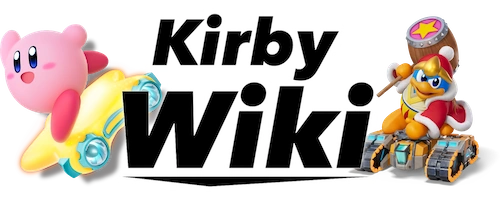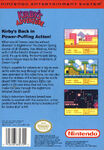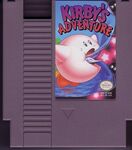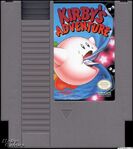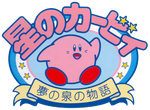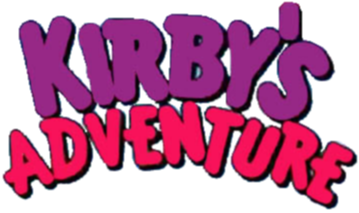| “ | In this game, players were introduced to Kirby's famous Copy Abilities. Kirby could get 24 different Copy Abilities in this game, including Sword, Cutter, Hammer, Spark, Stone, and Parasol. This gave players a wide range of new moves to play with and made it possible to play each stage in many ways. Kirby's Adventure was also the first game in the Kirby series to include minigames!” |
| — Summary • Kirby's Dream Collection: Special Edition |
Kirby's Adventure (released in Japan as 星のカービィ 夢の泉の物語, meaning Kirby of the Stars: The Story of the Fountain of Dreams) is a 1993 platform video game developed by HAL Laboratory and published by Nintendo for the Nintendo Entertainment System. It was originally released on March 23, 1993 in Japan, on May 1, 1993 in North America, and on December 9, 1993 in Europe. The second main installment in the Kirby series, it is best known for being the first game in the series to feature Copy Abilities, which are now synonymous with Kirby and the Kirby franchise, making this game at the very least as influential as Kirby's Dream Land (1992) in shaping successive games in the decades to come. It also was the first game to include sub-games, as well as the only NES game featuring Kirby.
It was remade in 2002 as Kirby: Nightmare in Dream Land, and the original was re-released in 2007 for the Wii Virtual Console. A second remake titled 3D Classics: Kirby's Adventure was released for the Nintendo 3DS, being one of six games given similar treatment by Arika. The game was also re-released on the Wii U Virtual Console and is one of the 30 games packaged with the NES Classic Edition console.
Plot
| “ | What would Dream Land be without dreams? A Nightmare!” |
| — Game cartridge • Kirby's Adventure |
The game starts with Kirby taking a nap, but something is wrong. Kirby has had no dreams, a truly unusual event in Dream Land. Kirby decides to visit the Fountain of Dreams, where all dreams spring from, to see if anything bad has happened to it. Upon his arrival, he finds King Dedede bathing in its waters. He finds that Dedede has broken the Star Rod, the power source of the fountain, into seven pieces, giving six pieces to his friends and keeping one himself. Kirby decides to track down the fragments to restore peaceful sleep and order to Dream Land.
Kirby gets harassed by enemies and the Meta-Knights along the way, but manages find to defeat King Dedede at the Fountain of Dreams and promptly replaces the Star Rod at its top, but Nightmare appears right after. Nightmare absorbs the powers from the Fountain and flies into the sky. King Dedede inhales Kirby and sends him after Nightmare, where they battle on Planet Popstar's moon. Kirby manages to defeat Nightmare, and the explosion ends up making a large circular hole in the moon, making it crescent-shaped. Kirby returns to the Fountain of Dreams and places the Star Rod back in there, and everything returns to normal with the dreams back in Dream Land. Dedede's prior actions were then revealed to be part of his plan to protect the Fountain from Nightmare, and Kirby and Dedede reconcile.
The game consists of seven worlds, which all have a boss. Each boss has one piece of the Star Rod.
Gameplay
Copy Abilities
Copy Abilities are first introduced in Kirby's Adventure, alongside Mix. Kirby retains all his jumping, flying and inhaling moves from Kirby's Dream Land.
Backdrop |
Ball |
Beam |
Crash |
Cutter |
Fire |
Fireball |
Freeze |
Hammer |
Hi-Jump |
Ice |
Laser |
Light |
Mike |
Needle |
Parasol |
Sleep |
Spark |
Star Rod |
Stone |
Sword |
Throw |
Tornado |
UFO |
Wheel |
(Mix) |
Level design
Kirby's Adventure's story is linear. Each stage is a side-scrolling platformer, with various enemies scattered around it, and each stage finishing with a Goal game. Each When one stage is cleared, the door to the next stage appears in the level's lobby. What makes the game lobby unique from most other games is that it is part of the actual game. The game lobby is like the side-scrolling stages.
The entire game is made of 7 individual lobbies each with seven stages. Every seventh stage a boss battle, and after a boss is defeated, the boss room will lead to the entrance to the next stage.
There are also sub-games in each lobby. Each level has 1 to 3 different sub-game rooms. Depending on the player's progress through the sub-games, they may earn bonus points or extra lives. A common one of these is the Museum, in which Kirby can swallow 1 or 2 different enemies for a free Copy Ability (the enemies cannot hurt him in this room). There is also the Arena, in which Kirby can fight a mid-boss to earn a Maxim Tomato, as well Warp Star Station, in which Kirby may take a Warp Star directly to another level. Sometimes, these bonus rooms must be unlocked through the use of secret switches in various stages.
Beating the game unlocks a Vs Boss mode on the main menu in which the player can face every boss in a row, and a Bonus Games mode in which the player can play each of the separate sub-games separately. Pressing all of the switches in the stages to unlock all of the sub-games in the levels will bring the game to 100% completion on the main menu and unlock the Extra Game. Beating the Extra Game will unlock the Sound Test for the game.
Levels
- Vegetable Valley
- Ice Cream Island
- Butter Building
- Grape Garden
- Yogurt Yard
- Orange Ocean
- Rainbow Resort
- The Fountain of Dreams
Sub-games
- Crane Fever
- Egg Catcher
- Quick Draw
- Arena (in Story Mode only)
- V.S. Boss! - Unlocked by beating the game once.
Goal Game
After each stage, the player plays a Goal Game where Kirby jumps on a spring platform. The goal is to press the A button when the platform is at its lowest--this sends Kirby to the top level and nets a 1UP. Otherwise the player scores between 5,000 to 100 points depending on how close the timing is to perfect.
Characters
Bosses
- Whispy Woods (Vegetable Valley)
- Paint Roller (Ice Cream Island)
- Mr. Shine & Mr. Bright (Butter Building)
- Kracko (Grape Garden)
- Heavy Mole (Yogurt Yard)
- Meta Knight (Orange Ocean)
- King Dedede (Rainbow Resort)
- Nightmare (above the Fountain of Dreams, then taken to Planet Popstar's moon)
| The following section contains transcluded content from the Database. Source: (view • edit • help) |
Mid-Bosses
Bonkers | Bugzzy | Fire Lion | Grand Wheelie | Meta-Knights (Axe Knight / Javelin Knight / Mace Knight / Trident Knight) | Mr. Frosty | Mr. Tick Tock | Rolling Turtle | Poppy Bros. Sr.
Enemies
Blade Knight | Blipper | Bomber | Bounder | Bronto Burt | Broom Hatter | Bubbles | Bugzzy Jr. | Cappy | Chilly | Coner | Cool Spook | Drill Ball | Explosive Coconut | Flamer | Glunk | Gordo | Hot Head | Kabu | Laser Ball | Noddy | Parasol | Parasol Waddle Dee | Pengy | Poppy Bros. Jr. | Rocky | Rolling Turtle Jr. | Scarfy | Shotzo | Sir Kibble | Slippy | Sparky | Squishy | Starman | Sword Knight | Togezo | Twister | Twizzy | UFO | Waddle Dee | Waddle Doo | Walky | Wheelie
3D Classics
The 3D Classics version of Kirby's Adventure is much more faithful to the original game than the previous remake, Kirby: Nightmare in Dream Land. At first glance it appears to be a direct port, but there are plenty of differences between this edition and the NES game. The most noticeable (and advertised) difference is the optional pop-up book-styled screen. There is also a different audio filter, meaning that sound effects usually don't "cancel" out. All of the game's slowdown was removed (noticeable with Spark). There are also slight touch-ups to the graphics such as flash effects (i.e. Crash), redesigned menus, slightly enhanced animation, water translucency, gradient skies and light peering through most obvious doors, as well as a few minor timing alterations (mostly in Goal Game and the sub-games). Many of the glitches removed in the French version and the first remake are also fixed in this edition. Other minor gameplay changes include customizable controls, the fact that Kirby will no longer waste any time in performing his victory dance, and Kirby will always be able to run across block-wide gaps (which was a point of frustration in the original game). Though the game does generally have more polish, there are some exclusive oversights - for example, Kirby's Vitality refreshes after the Heavy Mole fight (resulting in easier difficulty in V.S. Boss!), the game's total score is not saved during Extra Mode, and King Dedede can actually act as a Maxim Tomato using an exploit.
NES Remix 2

A Kirby's Adventure challenge in NES Remix 2.
Challenges based around Kirby's Adventure are included in this game.
Trivia
- The level names form an acronym "VIBGYOR", which is "ROYGBIV" backwards; the letters stand for the colors of the rainbow (red, orange, yellow, green, blue, indigo, and violet).
- The colors of the introductions sequences' frame of each level also match the color in the acronym (i.e. Butter Building's introduction is surrounded by blue, and Yogurt Yard's is surrounded by yellow). Additionally, the enemies appear in various colors throughout the game.
- Completing the Goal Game with results in order from 7 to 1 will result in Kirby receiving 30 1UPs.
- This trick would later be used in Kirby's Return to Dream Land and Kirby: Triple Deluxe.
- King Dedede's name is spelled two different ways in the end credits sequence: DeDeDe and Dedede.
- With around 6 megabits, Kirby's Adventure has the largest memory of any officially manufactured NES game cartridge.[4]
- The music for the Egg Catcher sub-game, the Arena and the boss theme was remixed as the music for the mid-boss theme in Kirby & The Amazing Mirror. This theme was, again remixed in Kirby: Canvas Curse. This theme, combined with the boss theme, was again remixed as the mid-boss theme (for Planet Popstar) for Kirby's Return to Dream Land.
- The Japanese commercial for this game has Kirby and all other characters made out of yarn. Some fans speculated that Kirby's Epic Yarn drew inspiration from this commercial. In actuality, Kirby's Epic Yarn was the final product of a completely separate game that was being developed by Good-Feel.
- The opening animation of Kirby being drawn is a recreation of a scene from the Japanese commercial for Kirby's Dream Land, right down to the song that plays during it.[5]
- According to the Kirby's 20th Anniversary Celebration Book, a few ideas were cut from the game. These include the power to dig holes, turn invisible, multiply, and even transform into a puddle of water.
- In an interview, Masahiro Sakurai, Satoru Iwata, and Shigeru Miyamoto revealed several scrapped Copy Ability ideas. These include an ability that creates Blocks, an ability that shrinks Kirby (which would later be repurposed for Kirby & The Amazing Mirror), an ability that had Kirby ride a rocket, and an ability that seems to be an early version of Animal.[6]
- Additionally, a commercial for Kirby's Adventure shows Kirby wearing a cowboy hat, belt, and boots wielding a gun. This may just be a representation of the Quick Draw sub-game.
- In the Music Room in Kirby and the Rainbow Curse, Kirby's Adventure is represented by an image of the Star Rod atop its pedestal on the Fountain of Dreams.
- When playing amiibo tap: Nintendo's Greatest Bits, if the player taps an amiibo product to the Wii U GamePad, there is a chance that he/she will unlock a demo of Kirby's Adventure.
- One of the game's music tracks, Legend of the Dream Spring, was featured at the beginning of "Revenge of the Creature Catcher", an episode of Casper's Scare School.
Music
| Main article: Kirby's Adventure/Music |
Glitches
| Main article: Glitch#Kirby's Adventure |
